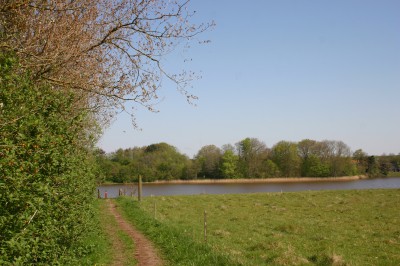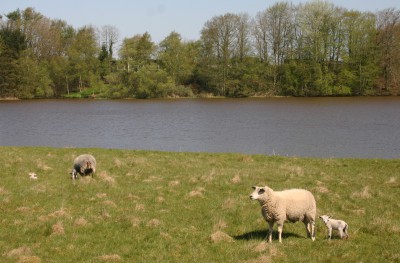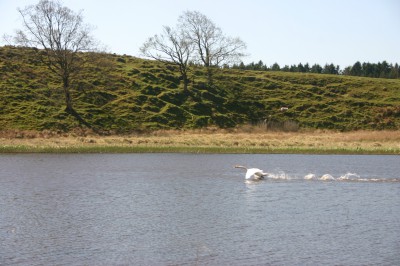I have
written about my travels in various exotic places but I also have adventures
closer to home. All I have to do is step out the door and start walking. Five
minutes later, I am on a path that leads me around Vandkraftsøen (literally ‘Water
power lake’).


The first
part of the walk leads me through a grassy field, which is where I take my
daily walks. At this time of year sheep and lambs abound. The lambs are
unabashedly cute. They are presently at the age at which they are discovering
friendships in each other. They romp, frolic and dash about while their docile
but watchful mothers graze.


Fifteen
more minutes of walking brings me to a small wood. The forest floor is white
with anemones (some of whom are sisters to the ones I have in my garden…) I
hear woodpeckers, chaffinches and warblers and, in the distance, kayakers and
canoeists on the lake. I get occasional
views of the lake on my left. A swan sits on her nest and stretches her neck to
pull in grasses and reeds and other building materials to add extra comfort for
the coming cygnets.

I pass by a
lovely, placid pond and pause to enjoy the stillness, so close to home yet lost
in my own little world for a spell.

The path is
steep and narrow at times, which I suppose is one of the reasons that it is not
overrun by crowds of people, even on such a fine day as this. I find more
anemones, including sunshine-y bright yellow ones.



Interesting
landmarks on the route are the little watermill (Tvis Mølle) and adjacent monastery
ruins (Tvis Kloster). I drive past these two historic sights every day on my
way to work. The watermill was reconstructed from the one that was built in the
1700’s but records show that there has been a watermill here since around the
late 12th century. It was owned by the Cisterciensian monastery Tvis
Kloster, which was established in 1163. The monastery fell into ruin and was
eventually removed but there are still remnants of it: the peaceful graveyard,
a few foundations, and stones in the modern paved road showing where the
monastery lay. The monastery was actually on a small island, snuggled between
two tributaries of Storåen. Denmark is filled with so much history –
fascinating!

 As I walk
As I walk
on the bridge to get to the other side of the lake, a swan gets it into its
head to skip like a stone along the water. Startled, I fumble with my camera to
catch a shot of the bird in mid-flight. However, the swan never rises above the
lake’s surface to fly but eventually settles down and starts grooming its
feathers.

The path
now follows the bicycle path I take when I visit my mother in her old age home
(if, lazy me, I don’t take the car instead). A few huge buildings sit on the
top of the hill with, I would guess, amazing views of the lake. They look like
office buildings but are actually private homes. Square boxes are the latest
architectural rage in Denmark for offices and private homes alike.



Shortly
thereafter are more sheep, lambs, peace and quiet. I pass very close by the
table and benches that I would bring my mother out to so we could enjoy a view
of the lake together. Now it is too far for her to walk, unfortunately.



I then walk
through a verdant cathedral. There are anemones on the forest floor and a light
green canopy formed by the newly unfurled leaves of the beech trees. Spring in
Denmark is a thing to behold! Who needs churches when you can rejoice in
nature? Nature can be harsh, though, as I am reminded when I spot a turquoise
egg that has fallen out if its nest. That broken egg will never become a bird.



The last
leg of the walk is more urban than the first part. I pass by the regional
television station TV MidtVest that must certainly be the place of employment
in Holstebro with the best view.

Next up is
the dam where the water rushes through with mighty force. Vandkraftsøen is an
artificial lake that was created to harness hydroelectric power from the river
that flows through Holstebro (Storåen, literally ‘The Big River’).

Then there
is the building that used to house the restaurant ‘Søens perle” (Pearl of the
Lake), where Johannes and I had our wedding reception on 7 June, 1986. A horse
and buggy drove us up right on the lawn while the guests awaited our arrival.
Those were the days. Now the building houses trade union offices. How
unromantic.

Back to
nature for a while again. There is a stream with water that is coloured brown from
ochre. The ochre in the water in our area is also what makes it hard to keep
white laundry white. Welcome to the land of grey bras and panties!

After two
hours of walking (eight kilometres) I wend my way down the streets of Mejdal,
the village where I live just outside of Holstebro, until I am home again and
back to my lush and somewhat wild garden.





